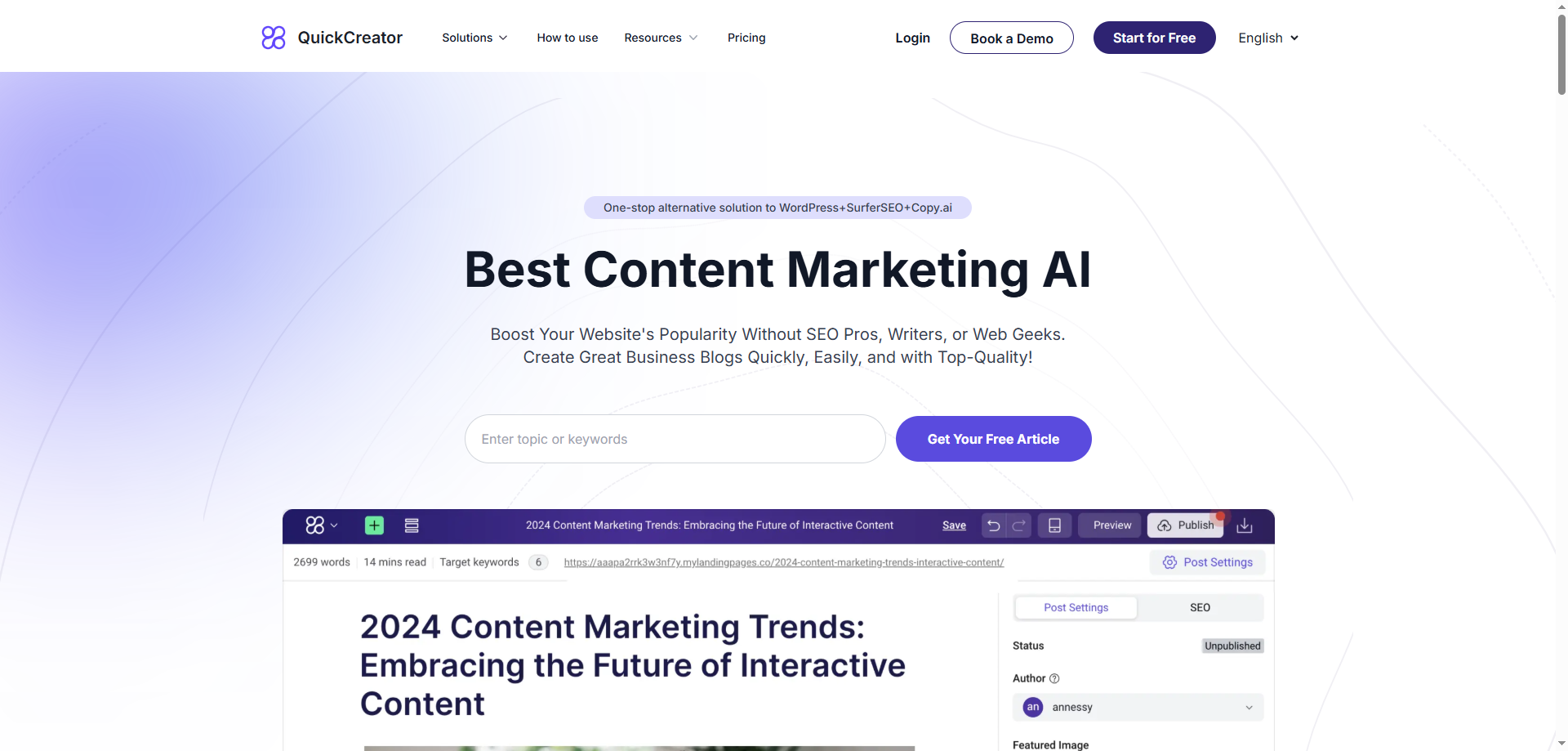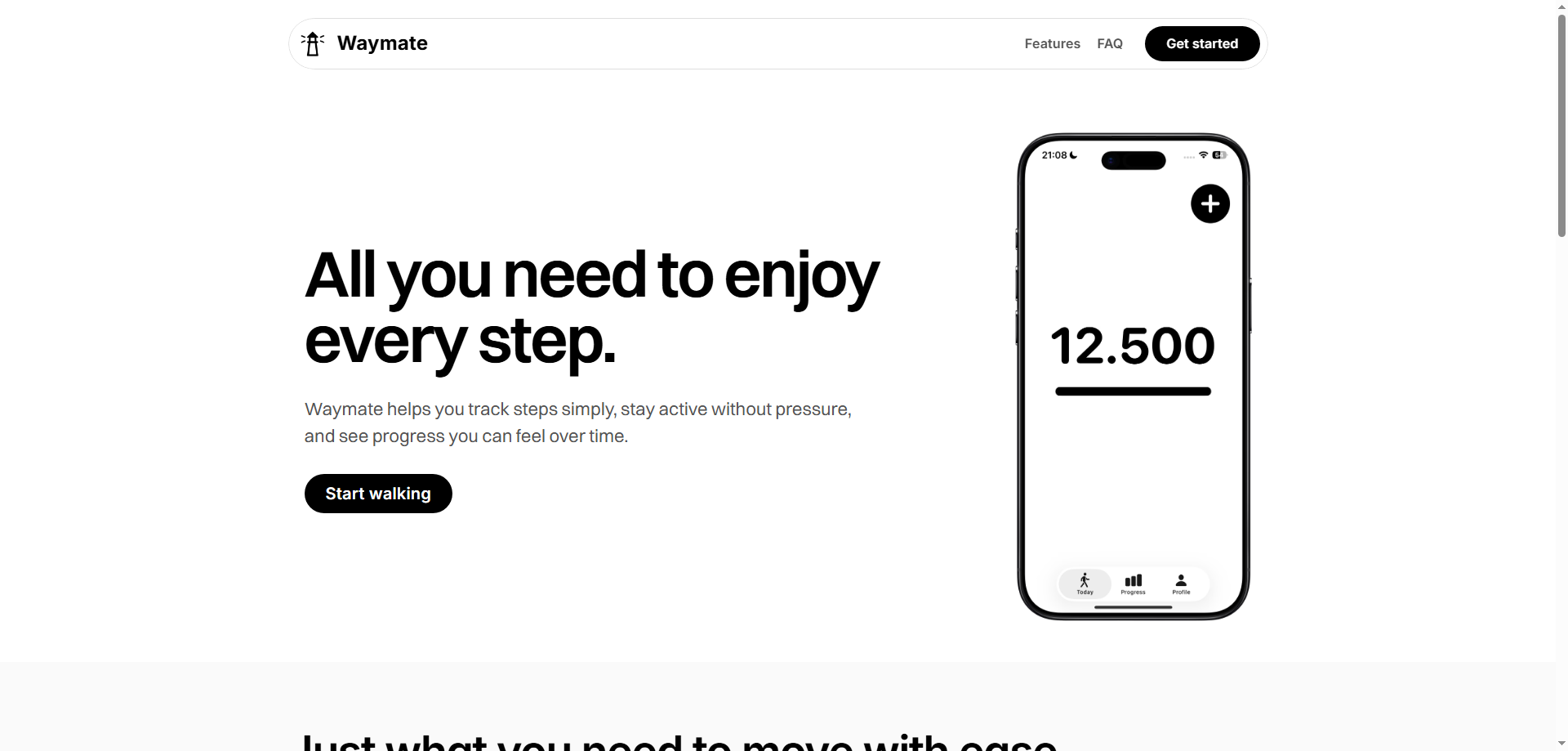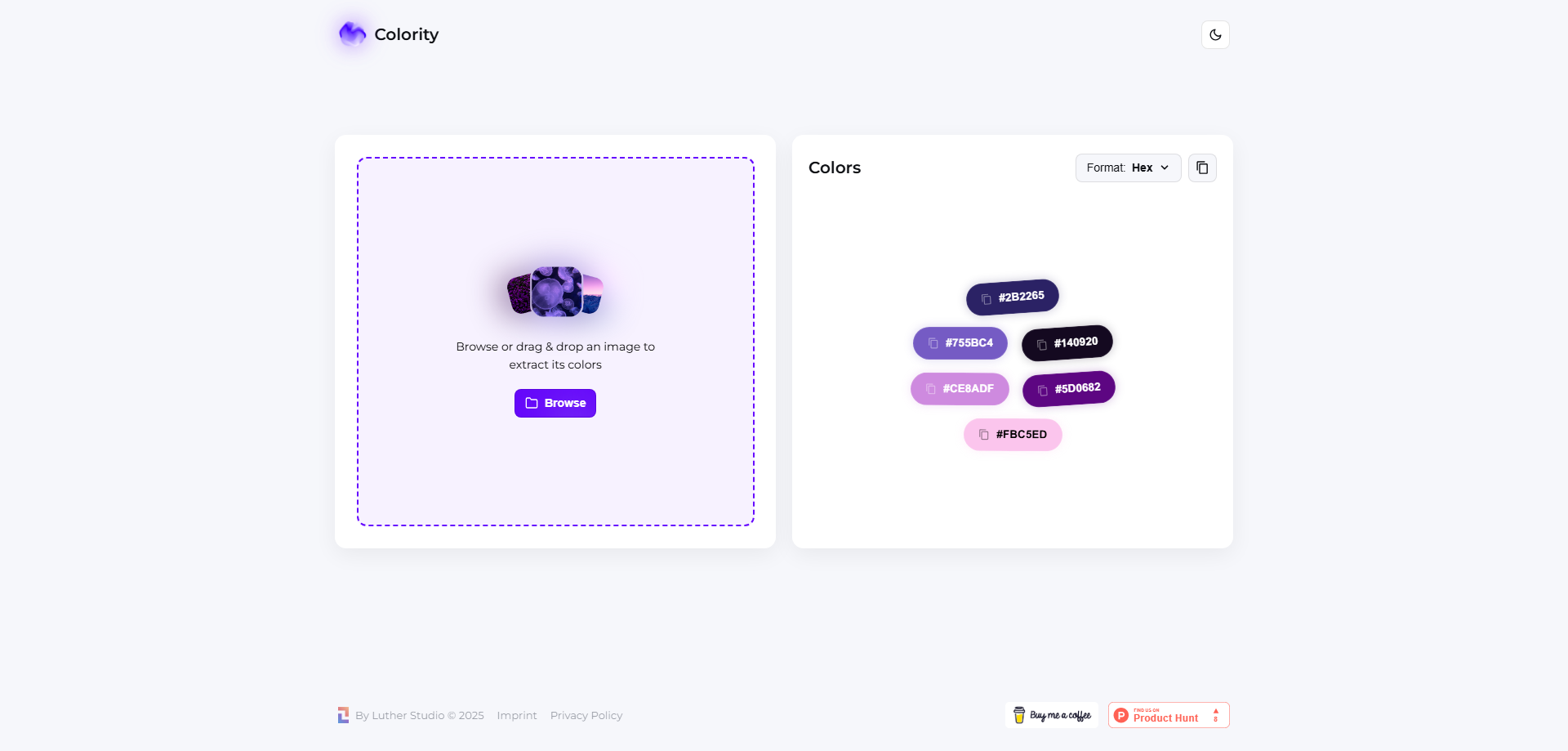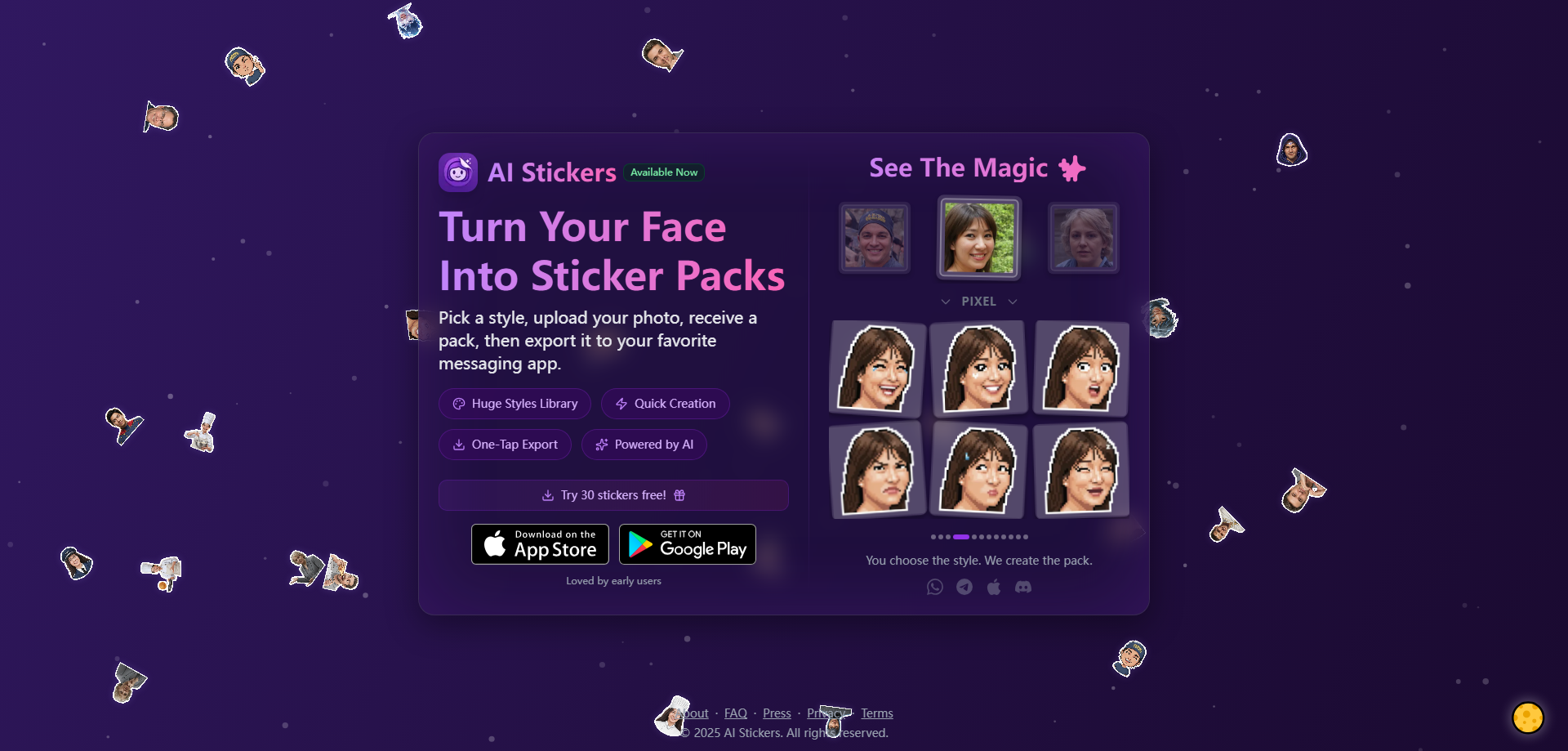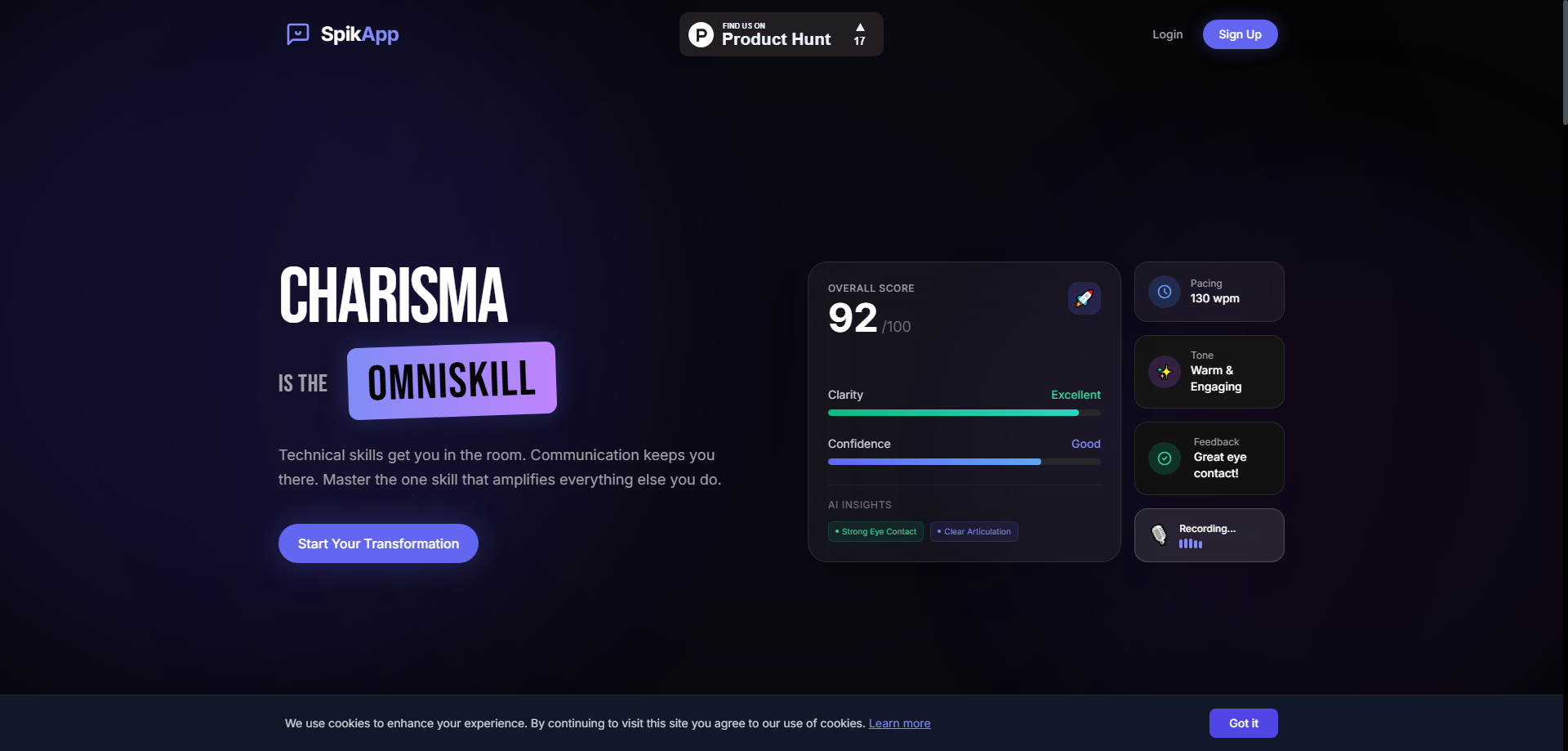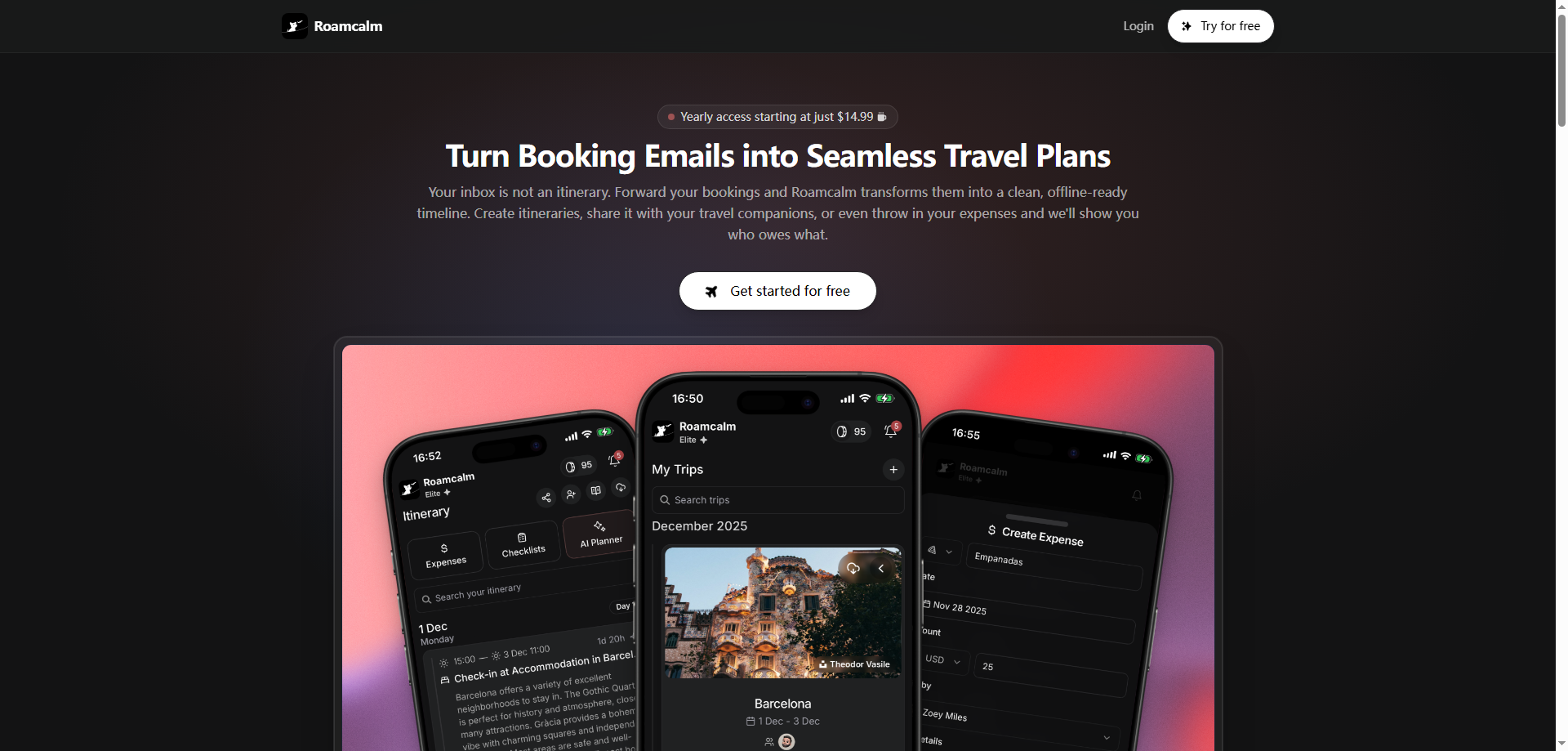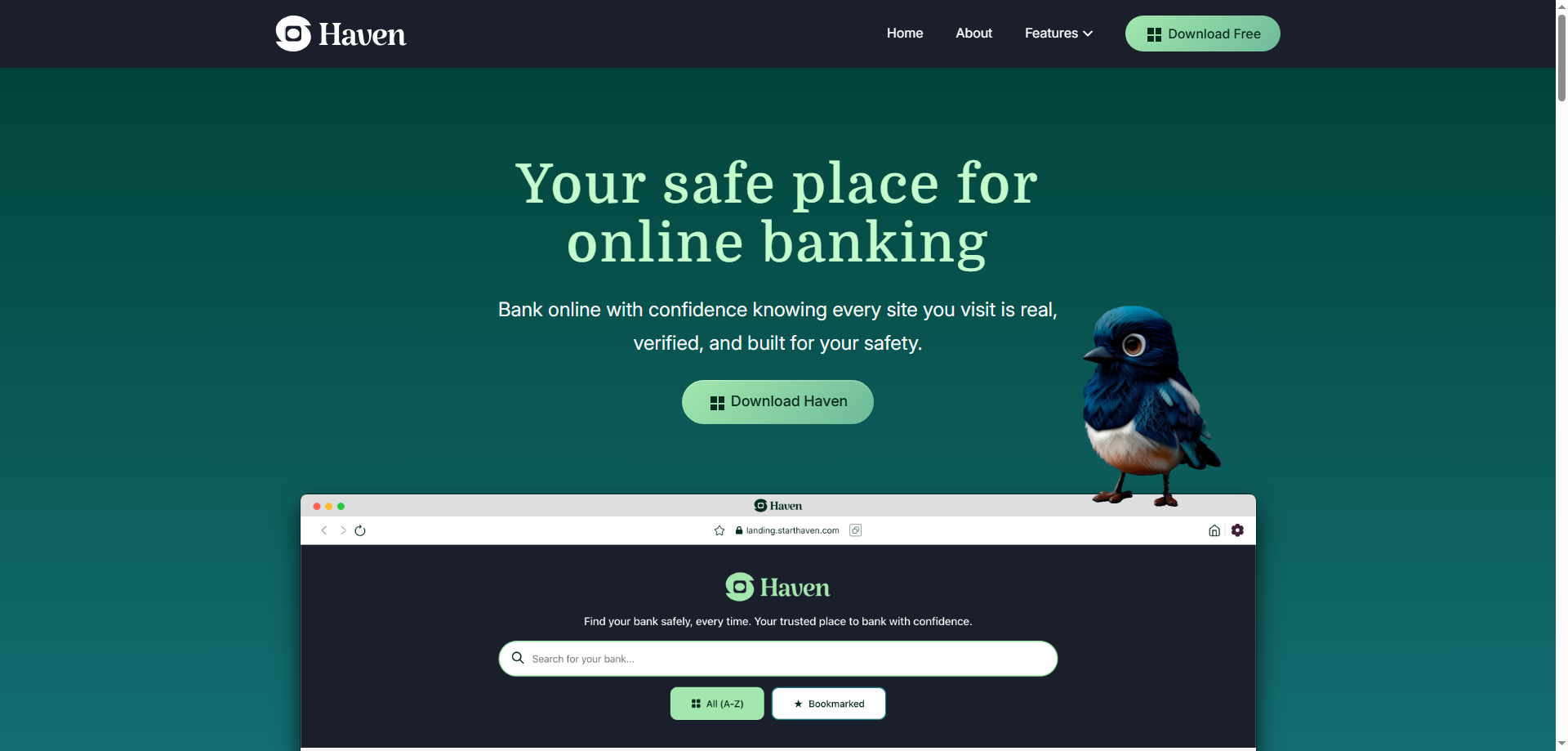Based on the provided content, here's a rewritten English introduction article about QuickCreator:
Revolutionize Your Content Creation with QuickCreator's AI-Powered Blog Writing Platform
In today's digital landscape, creating high-quality, SEO-optimized content consistently can be a challenging and time-consuming task. QuickCreator emerges as a game-changing solution, offering an advanced AI Blog Writer that transforms the way businesses, marketers, and freelancers approach content creation.
What Makes QuickCreator Stand Out
QuickCreator is more than just another AI writing tool—it's a comprehensive content creation ecosystem designed to produce humanized, SEO-optimized blog posts that drive organic traffic. The platform leverages real-time data integration and verified citations to ensure your content is both accurate and authoritative, addressing one of the most common concerns with AI-generated content.
The platform's sophisticated approach begins with keyword or topic input, after which the AI Blog Writer analyzes high-ranking articles, generates compelling titles and descriptions, conducts real-time research, and crafts content that resonates as authentically human. This process ensures that every piece of content not only meets SEO requirements but also maintains the unique voice and tone of your brand.
Comprehensive Feature Set for Modern Content Creators
QuickCreator's feature suite addresses every aspect of modern content creation. The AI-powered research capability eliminates the time-intensive process of manual research, while the brand voice customization ensures consistency across all your content. The platform automatically handles both internal and external link insertion, optimizing for SEO performance and enhanced user experience.
One of the platform's most valuable features is its automatic image insertion capability. The AI intelligently searches for and incorporates contextually relevant images, making articles more engaging and visually appealing without requiring manual intervention.
Multi-Language Support and Flexible Content Length
Recognizing the global nature of modern business, QuickCreator supports content creation in over 28 languages, making it an invaluable tool for international marketing efforts. The platform accommodates various content length requirements, with the free plan supporting up to 2,000 words and paid plans extending to 3,000 words, providing flexibility for different content strategies.
Built-in SEO Excellence
QuickCreator addresses SEO requirements through its built-in keyword and content quality scoring system. This feature helps ensure that articles align with Google's ranking factors, incorporating best practices for search engine optimization throughout the content creation process. The result is content that not only reads naturally but also performs well in search results.
Integrated Publishing Solutions
Rather than forcing users to juggle multiple platforms, QuickCreator includes a fully integrated blogging platform, eliminating the need for additional CMS systems. Users can set up and manage custom domains directly through the platform, streamlining the entire content-to-publication workflow.
For those who prefer existing platforms, QuickCreator's Growth plan and above offer seamless integration with popular systems like WordPress and Strapi, providing flexibility in how and where you publish your content.
Accessible Plans for Every Need
QuickCreator democratizes AI-powered content creation by offering a free plan that includes limited features and allows users to generate three AI articles, providing an opportunity to experience the platform's capabilities before committing to a paid plan. This approach makes advanced AI writing technology accessible to businesses and individuals at various stages of growth.
Perfect for Diverse Use Cases
The versatility of QuickCreator makes it suitable for numerous applications. Businesses can generate SEO-optimized blog posts to enhance their online presence, while marketing teams can create engaging content that drives audience engagement. Freelancers benefit from automated content creation capabilities that increase productivity, and organizations can build comprehensive knowledge bases using AI-generated articles.
QuickCreator represents a significant advancement in AI-powered content creation, combining the efficiency of artificial intelligence with the nuanced understanding required for effective digital marketing. By addressing common pain points in content creation—from research and writing to SEO optimization and publishing—QuickCreator provides a complete solution for modern content needs.
Whether you're looking to scale your content marketing efforts, improve your SEO performance, or simply streamline your writing process, QuickCreator offers the tools and capabilities to transform your approach to content creation while maintaining the authenticity and quality your audience expects.
Who Should Consider QuickCreator: My Analysis of Ideal Customer Segments
After thoroughly examining QuickCreator's capabilities and features, I've identified several distinct customer segments that would benefit most from this AI-powered blog writing platform. Through my analysis, I've found that the tool's unique combination of SEO optimization, multilingual support, and integrated publishing makes it particularly valuable for specific types of users.
Small to Medium-Sized Business Owners: The Content-Starved Entrepreneurs
In my experience analyzing digital marketing trends, I've observed that small business owners often struggle with consistent content creation due to limited resources and time constraints. QuickCreator addresses this challenge perfectly for businesses like local law firms, dental practices, or e-commerce stores that need regular blog content but lack dedicated writing staff.
Consider a boutique marketing agency I recently consulted with. They were spending 15-20 hours per week creating blog content for their own website while trying to serve clients. With QuickCreator's ability to generate complete, SEO-optimized posts in minutes, they could redirect those hours toward client work while maintaining their content marketing efforts. The platform's brand voice customization feature ensures their content maintains consistency, which is crucial for building authority in their niche.
Digital Marketing Agencies: Scaling Content for Multiple Clients
I've found that marketing agencies represent perhaps the most obvious fit for QuickCreator. These organizations often manage content strategies for dozens of clients across various industries, each requiring unique voice, tone, and specialized knowledge.
Take, for example, a digital agency managing accounts for a SaaS company, a restaurant chain, and a healthcare provider simultaneously. Without QuickCreator, they would need specialized writers for each industry. However, the platform's real-time data integration and verified citation features allow a single team to produce authoritative content across diverse sectors. The multilingual support becomes invaluable when serving international clients – I've seen agencies expand their service offerings to include Spanish, French, or German markets simply because they could now produce quality content in these languages.
Freelance Content Creators: The Productivity Multipliers
Through my interactions with freelance writers, I've noticed a clear divide between those who can scale their operations and those who remain trapped in hourly billing cycles. QuickCreator serves as a force multiplier for ambitious freelancers looking to increase their output without sacrificing quality.
A freelance writer I know was previously limited to producing 3-4 high-quality blog posts per week. Using QuickCreator as a research and first-draft tool, she now handles the initial content generation and focuses her expertise on editing, fact-checking, and adding unique insights. This approach allows her to take on 8-10 projects weekly while actually improving the quality of her deliverables through the platform's SEO optimization features.
E-commerce Businesses: Product-Focused Content at Scale
I've observed that e-commerce businesses often struggle with content marketing because they're primarily product-focused rather than content-focused organizations. QuickCreator bridges this gap effectively, especially for businesses with extensive product catalogs.
Consider an online electronics retailer with thousands of products. They need buying guides, comparison articles, and educational content to drive organic traffic. Previously, creating comprehensive articles like "Best Smartphones for Gaming in 2024" or "Complete Guide to Home Audio Systems" required significant research and writing resources. QuickCreator's ability to analyze high-ranking articles and integrate real-time data means they can produce authoritative product-related content that actually helps customers make informed decisions.
International Businesses: Breaking Language Barriers
The platform's support for over 28 languages makes it invaluable for businesses expanding into global markets. I've seen companies struggle with localization because hiring native writers for each target market is expensive and time-consuming.
A software company I analyzed was planning expansion into Latin American markets but was concerned about content localization costs. QuickCreator enabled them to produce quality Spanish and Portuguese content for their blog, helping establish thought leadership in these new markets before investing in local marketing teams. The platform's SEO optimization works across languages, ensuring their international content performs well in local search results.
Educational Institutions and Training Companies: Knowledge Base Development
I've found that educational organizations and corporate training companies represent an underexplored opportunity for QuickCreator. These entities need to create extensive knowledge bases, course materials, and educational content regularly.
A corporate training company I worked with needed to develop curriculum materials for various industries quickly. QuickCreator's verified citation feature proved invaluable for creating credible educational content, while the platform's ability to maintain consistent voice helped them develop comprehensive training programs across different subject areas.
Startups in Growth Phase: Resource-Efficient Content Marketing
Startups face unique challenges: they need significant content output to build brand awareness but typically operate with limited budgets and small teams. I've observed that QuickCreator fits perfectly into the lean startup methodology.
A fintech startup I advised was competing against established players with much larger marketing budgets. By using QuickCreator to produce educational content about personal finance, cryptocurrency, and investment strategies, they built thought leadership without hiring a full content team. The platform's integrated blogging feature meant they didn't need to invest in additional CMS infrastructure, keeping their operational costs low during the crucial growth phase.
Who Might Not Be the Best Fit
Through my analysis, I've also identified segments where QuickCreator might not be the optimal solution. Large enterprises with established editorial teams and complex approval processes might find the platform's rapid content generation conflicts with their existing workflows. Similarly, highly specialized technical publications requiring deep subject matter expertise might need more human oversight than the platform currently provides.
The Bottom Line
My analysis reveals that QuickCreator's ideal customers share common characteristics: they need consistent, high-quality content but lack the resources for large writing teams. They value efficiency and SEO performance over highly specialized, niche content. Most importantly, they're looking to scale their content operations without proportionally scaling their costs.
The platform succeeds by democratizing professional content creation, making enterprise-level capabilities accessible to smaller organizations. Whether you're a solo freelancer looking to increase productivity or a growing business needing consistent content marketing, QuickCreator provides the tools to compete with larger, better-resourced competitors in the content landscape.
My Guide to Testing QuickCreator: A Practical Approach with Important Warnings
After working with various AI content tools over the years, I've developed a systematic approach to evaluating platforms like QuickCreator. Let me walk you through how I recommend testing this tool, along with the critical risks you need to understand before committing to it for your business.
Starting Your Test Run: The Free Plan Strategy
I always recommend beginning with QuickCreator's free plan, which gives you three AI-generated articles up to 2,000 words each. This limitation is actually beneficial for testing purposes because it forces you to be strategic about what you evaluate.
Here's how I approach the initial test: I select three different types of content that represent my typical needs. For instance, if I'm running a marketing agency, I might test with a how-to guide, a product comparison article, and an industry trend piece. This variety helps me understand how the tool performs across different content formats and complexity levels.
My Step-by-Step Testing Process
When I first log into QuickCreator, I start with a keyword I know well—something in my area of expertise where I can easily spot inaccuracies or shallow research. I input the keyword and observe how the platform analyzes high-ranking articles. This initial analysis phase tells me a lot about the tool's research capabilities.
I pay close attention to the title and description generation. Does it create compelling, SEO-friendly titles that I would actually use? Are the meta descriptions within character limits and genuinely descriptive? I've found that weak title generation often indicates broader content quality issues.
During the content generation phase, I monitor several key factors. First, I examine the structure and flow—does the article follow a logical progression? Second, I verify the factual accuracy of claims made, especially any statistics or data points. Third, I assess whether the content maintains a consistent voice that could reasonably match my brand.
Testing the SEO Features: What I Look For
The built-in SEO scoring is one of QuickCreator's key selling points, so I test this thoroughly. I examine whether the tool naturally incorporates keywords without over-optimization. I check if the internal and external links it suggests are genuinely relevant and valuable to readers.
I particularly scrutinize the automatic image insertion feature. Are the images contextually appropriate? Do they enhance the content or feel like random additions? I've seen AI tools insert irrelevant stock photos that actually detract from the user experience.
Critical Risk Assessment: What You Must Watch Out For
Based on my experience, there are several significant risks you need to evaluate during your testing phase. The most serious concern I've encountered with AI content tools is factual accuracy. Even with QuickCreator's verified citation claims, I strongly recommend fact-checking every statistic, date, and specific claim in the generated content.
I've discovered that AI tools can confidently present outdated information or misinterpret data from their sources. For example, when I tested content about social media statistics, the tool cited accurate sources but sometimes pulled figures from different years or contexts, creating misleading impressions.
Another major risk is the potential for AI detection by search engines or clients. While QuickCreator claims its content passes AI detection, I recommend testing your generated articles through multiple AI detection tools like GPTZero or Originality.ai. In my tests, results have been inconsistent—some content passes easily while other articles are flagged as potentially AI-generated.
Brand Voice Authenticity: The Toughest Test
I always test the brand voice customization feature with content I would typically write myself. This is where I've found the most significant limitations. While the tool can mimic certain stylistic elements, it often lacks the nuanced understanding of industry-specific terminology or the subtle tone variations that establish true thought leadership.
For instance, when I tested content for a cybersecurity client, the tool produced technically accurate but generic advice that lacked the specific insights and experience-based perspectives that distinguish expert content from basic informational articles.
Integration Testing: Beyond Content Creation
If you plan to use QuickCreator's integrated blog platform, I recommend testing the publishing workflow thoroughly. Upload test content, experiment with custom domain setup if you need it, and evaluate the overall user experience from creation to publication.
For WordPress or Strapi integration (available on Growth plans and above), I suggest testing the export and import process. Does the formatting transfer correctly? Are links preserved? Do images embed properly? I've encountered situations where content looks perfect in the QuickCreator editor but has formatting issues when published elsewhere.
Multilingual Capabilities: Proceed with Caution
If you're considering QuickCreator for multilingual content, I recommend extreme caution during testing. While the platform supports over 28 languages, the quality varies dramatically between languages. I've found that content in major languages like Spanish, French, and German tends to be more reliable than less common languages.
However, even with major languages, cultural nuances and local market knowledge often get lost. I strongly advise having native speakers review any multilingual content before publication, as direct translations of concepts don't always resonate with local audiences.
Performance and Reliability Testing
During my testing period, I track the tool's consistency and reliability. How long does content generation actually take? Does the platform experience downtime? Are there usage limits that aren't clearly disclosed upfront?
I also test the customer support responsiveness by reaching out to [email protected] with questions during my trial period. The quality of support becomes crucial if you're relying on this tool for client work or important business content.
My Final Testing Recommendations
Before committing to QuickCreator, I suggest comparing the generated content directly with content you would produce manually or hire writers to create. Consider not just the time savings, but the quality difference and any additional editing or fact-checking time required.
Test the tool with your actual target keywords and topics, not just generic examples. The platform's performance can vary significantly depending on topic complexity and niche specificity.
Most importantly, never publish AI-generated content without human review, regardless of how impressive it appears during testing. I've learned that the most dangerous AI content isn't obviously bad—it's the content that seems authoritative but contains subtle inaccuracies or outdated information.
Remember that QuickCreator, like any AI tool, is best viewed as a starting point rather than a complete solution. Use your testing period to determine whether it can serve as an effective foundation for your content creation process, with the understanding that human oversight and editing will likely remain essential for professional-quality results.
The key to successful testing is maintaining realistic expectations while thoroughly evaluating the tool's fit for your specific needs and quality standards.
My In-Depth Analysis of QuickCreator: Core Strengths, Critical Flaws, and Better Alternatives
After extensively analyzing QuickCreator's feature set and testing various AI content platforms, I've developed a comprehensive understanding of where this tool excels and where it falls short. Let me share my honest assessment and recommend alternatives that might better serve different use cases.
Core Functions Analysis: What QuickCreator Does Well
From my evaluation, QuickCreator's strongest asset is its integrated approach to content creation. Unlike many AI writing tools that focus solely on text generation, QuickCreator attempts to address the entire content workflow from research to publication. The real-time data integration feature represents a significant advantage over static AI models that rely on outdated training data.
I'm particularly impressed with the platform's SEO optimization capabilities. The built-in keyword and content quality scoring system addresses a major pain point I've observed with other AI tools—content that reads well but performs poorly in search results. The automatic internal and external link insertion, when it works correctly, saves considerable editing time.
The multilingual support for over 28 languages is genuinely useful, though with important caveats I'll address in the flaws section. For businesses expanding internationally, this feature can provide a starting point for localized content that would otherwise require significant investment in native writers.
The integrated blogging platform is a smart strategic move. By eliminating the need for separate CMS systems, QuickCreator reduces the technical barriers for small businesses and solo entrepreneurs who want to maintain a content marketing presence without managing multiple platforms.
Critical Flaws and Limitations I've Identified
Despite these strengths, I've discovered several significant limitations that potential users must consider. The most concerning issue is the lack of transparency around the "verified citations" claim. While the platform mentions using verified sources, I couldn't find detailed information about how citations are validated or what constitutes a reliable source in their system.
The word count limitations reveal a fundamental constraint that affects content depth. The free plan's 2,000-word limit and paid plans' 3,000-word ceiling means you cannot create comprehensive, authoritative long-form content that often performs best for competitive keywords. In my experience, truly comprehensive guides and tutorials often require 4,000-6,000 words to adequately cover complex topics.
Brand voice customization, while advertised as a key feature, appears to be relatively superficial based on the available information. True brand voice goes beyond style and includes industry expertise, unique perspectives, and nuanced understanding of audience pain points—elements that AI tools struggle to replicate authentically.
The integration limitations present another concern. While WordPress and Strapi integration is available on higher-tier plans, the absence of explicit Shopify support is problematic for e-commerce businesses. Many content creators work with diverse client bases that use various platforms, and limited integration options restrict flexibility.
Workflow and Usability Concerns
From a practical standpoint, I've identified several workflow issues. The inability to modify outlines during the writing process—at least, this capability isn't clearly documented—suggests a rigid content creation approach that doesn't accommodate the iterative nature of professional writing.
The automatic image insertion feature, while convenient, raises quality control concerns. AI-selected images often lack the contextual relevance and brand consistency that professional content requires. This feature might save time initially but could require significant manual review and replacement.
Alternative Solutions I Recommend
Based on my analysis of the market, several alternatives offer different advantages depending on your specific needs.
Jasper (formerly Jarvis) remains my top recommendation for businesses requiring sophisticated brand voice capabilities. Their Boss Mode feature provides more granular control over tone and style, and their template library is more extensive than QuickCreator's offerings. However, Jasper focuses primarily on content generation rather than the integrated platform approach.
Copy.ai offers stronger collaborative features for teams and more flexible word count limits. Their workflow automation capabilities are more advanced, allowing for complex content creation processes that QuickCreator cannot match. The pricing is also more transparent and scalable.
Writesonic provides better SEO integration through partnerships with tools like SEMrush and Ahrefs. If SEO performance is your primary concern, Writesonic's keyword research and optimization features are more sophisticated than QuickCreator's built-in scoring system.
ContentKing (now part of Conductor) offers superior content performance tracking and optimization suggestions. While it's more expensive, the analytical capabilities far exceed what QuickCreator provides for understanding content effectiveness.
For businesses specifically needing multilingual capabilities, Localazy combined with DeepL Write provides more accurate translation and cultural adaptation than QuickCreator's multilingual features. This combination requires more setup but delivers superior results for international content.
Specialized Alternatives for Different Use Cases
For e-commerce businesses frustrated by QuickCreator's limited Shopify integration, Copysmith offers better product description generation and e-commerce-specific templates. Their integration with Shopify, WooCommerce, and other platforms is more comprehensive.
Freelancers and agencies might find Rytr more cost-effective for basic content generation, though it lacks QuickCreator's integrated platform features. The significant price difference might justify using Rytr for content generation and a separate CMS for publishing.
For technical content creation, Notion AI integrated with their workspace provides better collaborative editing and knowledge management features. While it's not specifically designed for SEO content, the editing and collaboration capabilities are superior for technical documentation and knowledge bases.
My Honest Recommendation
After this comprehensive analysis, I believe QuickCreator occupies an interesting middle ground that may not satisfy users at either end of the spectrum. Power users will find the customization and advanced features lacking compared to specialized tools, while casual users might be overwhelmed by features they don't need.
The platform seems best suited for small businesses or solo entrepreneurs who value the integrated approach over best-in-class individual features. If you need a simple, all-in-one solution and can accept limitations in customization and advanced functionality, QuickCreator could work for your needs.
However, if content quality, advanced SEO capabilities, or extensive integrations are priorities, I recommend investing in specialized tools or combinations of tools that excel in specific areas. The additional complexity of managing multiple platforms often pays dividends in terms of content quality and performance.
The three-article free trial is valuable for testing, but I strongly suggest comparing QuickCreator's output with at least two alternatives before committing to a paid plan. The AI content landscape is evolving rapidly, and better solutions may emerge that address QuickCreator's current limitations while maintaining its integrated approach advantages.
Ultimately, the best tool depends on your specific workflow, quality requirements, and budget constraints. My analysis suggests that while QuickCreator is a competent platform, it's not necessarily the best choice for most content creation scenarios.
